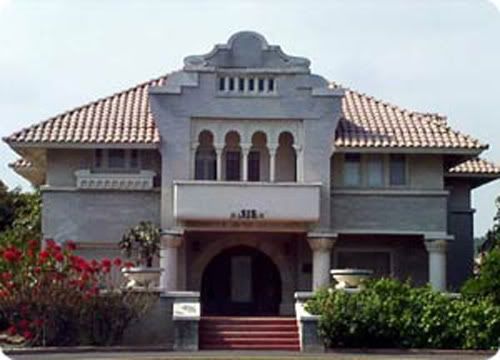In Fullerton: a Pictorial History, Bob Ziebell writes, “the Klan was active in the community, mostly in the first half of the 1920s, and its members included leaders in government, education, business, and religion” (116). Interestingly, Ziebell does not name names, probably because many of these “leaders” have streets, monuments, and schools named after them. Recently, Orange County writer and historian Gustavo Arellano has published a series of blog posts on the OC Weekly site, about some possible Fullerton Klan members, including Herman Hiltscher, Williiam Starbuck, and Albert Hetebrink.
While he does not name names, Ziebell does recount one incident that is indicative of the popularity of the Klan in the 1920s in Fullerton: “Dan O’Hanlon, local realtor and staunch Irish Catholic, was among five thousand people attending a Klan rally in Amerige Park in June 1924” (117).
Let me stop there for a second. FIVE THOUSAND people at a Klan rally in Fullerton?! Given the fact that the entire population of Fullerton was less than 10,000 at the time, that’s a HUGE number of Klan supporters.
Ziebell continues, “[O’Hanlon] stood up and called the speaker a liar after unfavorable references to the Catholic church were made...Fullerton police officers stepped in and whisked O’Hanlon away as a crowd shouting ‘Get that guy,’ and ‘Where is a tar bucket,’ began to encircle him...that night a fiery cross was burnt at the O’Hanlon home” (117). This account, Ziebell notes, comes from a 1979 doctoral dissertation by a UCLA student entitled The Invisible Government and the Viable Community: The Ku Klux Klan in Orange County, California During the 1920s.
Ziebell points out that the Klan in Fullerton did not particularly target blacks, because blacks accounted for less than .05 percent of the population at the time. Fullerton has never really been a popular city for African Americans.
The minority group most often targeted by the Klan was Mexicans, who were segregated from the white population and confined to work camps (they picked the Oranges that gave Orange County its name). Druzilla Mackey, a teacher in the Fullerton School District’s “Americanization” program in the 1920s describes these work camp/colonies as being made up of ‘hovels’ constructed of scrap sheet metal, discarded signs and fence posts. The largest of the colonies had thirty families “served by one lone water faucet and a few makeshift privies” (quoted in Ziebell, 120).
A bit of historical irony is the fact that this camp was located on the Bastanchury Ranch, the current site of several upscale gated communities in Fullerton. But even at the time, there was great social disparity between the Mexicans and the “whites.” Rancher Albert Hetebrink, whose family owns this stately house that currently stands next to Fullerton College, was a Klan member, according to Gustavo Arellano's facscinating series of blog posts: Profiles in OC Pioneers Who Were Klan Members.

The Hetebrink House
